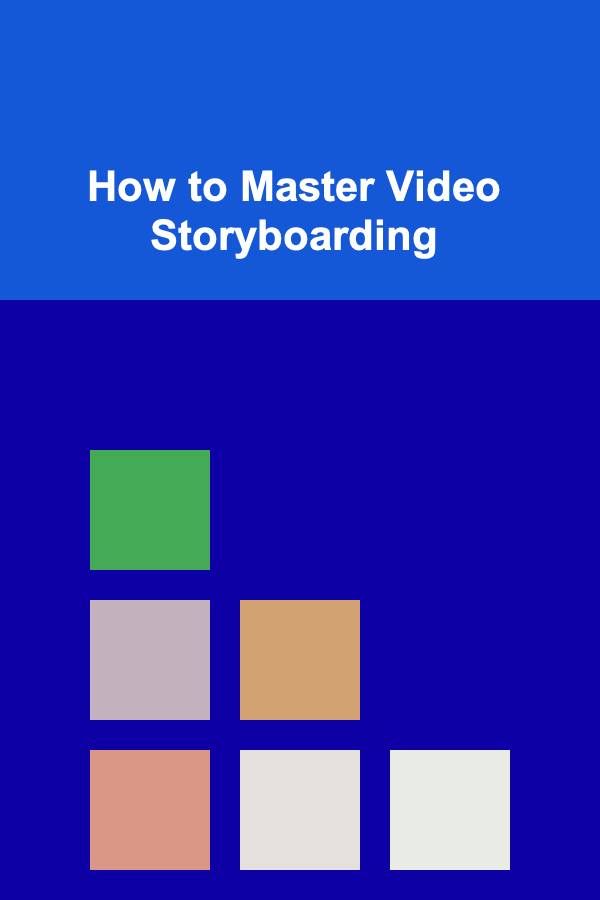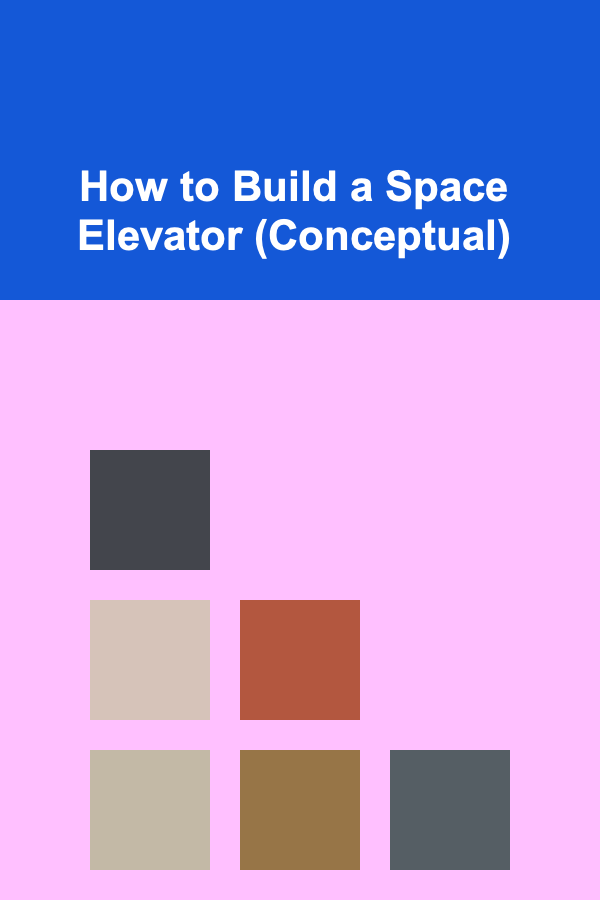
How to Master Video Storyboarding
ebook include PDF & Audio bundle (Micro Guide)
$12.99$5.99
Limited Time Offer! Order within the next:

Storyboarding is one of the most critical aspects of the video production process, whether for films, advertisements, music videos, animations, or corporate videos. A well-thought-out storyboard can make a significant difference in how smoothly your project comes together. This article will explore the essential components of video storyboarding, from understanding its purpose to advanced techniques for mastering the craft.
What Is Storyboarding?
Storyboarding is a visual planning process used by filmmakers, animators, video producers, and content creators to sketch out scenes of a video before shooting or production begins. It acts as a blueprint for your video project, helping to pre-visualize the narrative and shot composition. Think of it as a comic strip of the film you intend to create, allowing all involved to visualize what will unfold scene by scene.
Storyboarding typically involves drawing or sketching the sequence of scenes, placing visual cues that indicate the camera movements, character actions, and transitions. It serves to clarify the director's vision, reduce confusion during filming, and ensure that everyone on set or involved in the production understands the creative vision. The process also helps identify potential issues before filming begins, saving time and money.
Why Is Storyboarding Important?
- Visual Planning: A storyboard allows the team to see a visual representation of the entire video or film before any actual production takes place. This enables producers and directors to evaluate whether their ideas work cohesively or if adjustments need to be made.
- Organizing Scenes: It helps in organizing scenes in a structured way. When you break down each sequence visually, you can see where the narrative needs pacing, where action happens, and where transitions need to be smoother.
- Effective Communication: A storyboard acts as a communication tool between all team members involved in the project. From the director to the cinematographer, to the production designers and animators, everyone can refer to the storyboard to understand their specific role and expectations.
- Visualizing Complex Shots: For intricate sequences or special effects shots, a storyboard helps visualize how complex camera movements or digital effects will play out. This saves considerable time and effort when filming, as all crew members have a clear idea of how each shot will look.
- Cost and Time-Efficient: A well-prepared storyboard can save significant time on set by preventing unnecessary changes, retakes, or confusion. It can also help estimate the production time for each scene, making the entire video project more efficient.
Types of Storyboards
There are different types of storyboards, each suited to specific types of production. Let's examine the most common ones:
1. Traditional Paper Storyboards
The traditional form of storyboarding is done by hand on paper. This method involves drawing each scene or shot, usually with brief annotations or descriptions alongside. These can be relatively simple sketches or highly detailed representations, depending on the needs of the project. Many filmmakers and animators still prefer this approach for its tactile nature and ease of use.
2. Digital Storyboards
With the rise of digital tools, many modern filmmakers and content creators now use digital platforms to create their storyboards. Software like Storyboard Pro, Photoshop, and even PowerPoint can be used to design storyboards with greater precision and flexibility. Digital storyboarding allows for easy adjustments, rearranging of scenes, and the addition of colors and more refined visuals.
3. Animatics
Animatics are essentially animated versions of storyboards. These are typically created by animating the still images of a storyboard and adding temporary voiceover or sound effects to simulate the final result. Animatics help to better visualize timing, pacing, and transitions and are often used in animation and film production to check the flow before fully producing the video.
4. Thumbnail Storyboards
Thumbnail storyboards are small, simple sketches that capture the essence of each shot in a scene. These are more for quick planning and brainstorming, focusing less on detail and more on capturing the composition and general feel of the shots. While not as detailed as full storyboards, they are incredibly useful for early-stage planning and ideation.
Steps to Master Video Storyboarding
Mastering the art of storyboarding involves a mixture of creativity, technical knowledge, and an understanding of the broader video production process. Here's a step-by-step guide on how to master video storyboarding:
1. Understand the Script and Concept
Before you start sketching, it's essential to fully understand the project. Read through the script or outline thoroughly to grasp the narrative, characters, and themes. Understanding the flow of the story, its key moments, and the director's vision will give you the clarity to translate this vision onto a storyboard.
You need to identify the core emotional beats and narrative structure. Consider the type of video you're working on---whether it's an action-packed sequence, a slow-paced emotional moment, or a complex dialogue scene. Your storyboarding style will need to align with the mood and pace of the script.
2. Break Down the Script into Scenes and Shots
Once you have a good understanding of the script, the next step is to break it down into individual scenes and shots. This step requires identifying the major moments in the script, the transitions between them, and how the shots will be composed.
Some questions to ask during this process:
- What is the focal point of this scene?
- Who are the main characters?
- Where does the scene take place?
- What is the intended mood or emotion?
This step also involves choosing the type of shots (wide shot, medium shot, close-up) and understanding how the camera will move (panning, tracking, zooming, etc.).
3. Create a Shot List
A shot list is a detailed breakdown of all the shots you intend to include in your video. Each shot should have a description and specify elements such as camera angles, movements, framing, lighting, and blocking (the arrangement of actors in a scene). A good shot list ensures that every moment of your video has a planned visual representation.
4. Sketch the Storyboard
Now comes the drawing stage. Whether you're using traditional methods or digital tools, begin by drawing the shots and scenes, keeping the following in mind:
- Composition: Focus on how each shot will be framed, including the background, objects, and characters. Think about the rule of thirds, leading lines, and depth of field.
- Camera Movement: Illustrate the direction and type of camera movement (tracking, tilting, zooming, etc.) and include arrows or annotations to indicate the movement.
- Timing: Storyboards should include rough time estimates or indicators to help visualize how long each shot will last. This ensures proper pacing when the video is shot and edited.
- Characters and Blocking: Draw the key actors and props in each scene to show where everyone will be positioned in the frame.
Your sketches don't have to be intricate; they should be clear enough to communicate the shot's intent.
5. Add Annotations
Along with the visuals, it's essential to include brief annotations that explain important details about each shot. These can include:
- Camera angles: Specify if the shot is a high-angle, low-angle, or eye-level shot.
- Lighting notes: If specific lighting setups are needed, include instructions for the lighting team.
- Sound or Dialogue: For scenes with important dialogue or sound effects, note what will happen in the background.
- Props or special effects: If a scene requires specific props, costumes, or visual effects, mark it down.
6. Review and Revise
Once your storyboard is complete, review it in its entirety to ensure the flow of the video is coherent. Ask yourself:
- Do the scenes flow logically?
- Are the camera angles and movements in line with the script?
- Are the emotional beats captured appropriately?
It can also be helpful to share the storyboard with other team members to get feedback. Collaboration is key, and fresh eyes may highlight potential issues or improvements that you missed.
7. Use Animatics to Test Timing and Transitions
If you're working on a more complex project, you may want to create an animatic. This animated version of the storyboard will help visualize timing, pacing, and transitions between shots. Animatics are particularly useful for animation and feature films, where precise timing is critical.
8. Continuously Learn and Improve
The more you practice storyboarding, the more skilled you'll become. Study the work of professional storyboard artists, watch films and analyze their shot compositions, and learn from your own experiences. Over time, you'll develop your unique style and approach to storyboarding that fits the specific needs of each project.
Advanced Storyboarding Techniques
As you become more proficient in storyboarding, you'll want to refine your skills with some advanced techniques:
1. Camera Angles and Movement
Understanding how to manipulate the camera is crucial for effective storyboarding. Advanced storyboarding includes thinking deeply about the camera's role in the narrative. Play with different angles---high, low, and extreme close-ups---and think about how camera movements like dolly shots or crane shots can enhance the emotional impact of a scene.
2. Dynamic Framing
Learn how to frame shots dynamically. Instead of static compositions, use the framing to convey emotions or relationships between characters. For example, in a tense scene, you might choose to create a close-up shot to emphasize a character's expression.
3. Master the Rule of Thirds
The rule of thirds divides a frame into nine equal parts by two horizontal and two vertical lines. Placing key elements along these lines or at their intersections creates balanced, visually pleasing compositions. It's one of the most fundamental principles in visual storytelling.
4. Incorporating Visual Effects
In modern storyboarding, especially for animated or special effects-heavy productions, integrating visual effects into the storyboard is essential. Indicate where the effects should happen and whether they will be computer-generated or practical effects.
Conclusion
Mastering video storyboarding is an invaluable skill for any filmmaker, animator, or content creator. It helps visualize the video before production, ensuring that the creative vision is realized on screen. By learning how to break down scripts, sketch shots, and communicate effectively with your team, you'll streamline the production process and ensure a more cohesive final product. Practice, feedback, and continued learning are the keys to becoming an expert in storyboarding, and with time, you'll be able to bring any script to life.

How to Create a Comprehensive Pantry Inventory List
Read More
How to Create a Relaxing Yet Fun Atmosphere for a Laid-Back Party
Read More
How to Organize Baking Supplies in a Drawer
Read More
How to Discover Series with Standout Performances
Read More
How to Conquer Your Fear of Heights for Adventure
Read More
How to Build a Space Elevator (Conceptual)
Read MoreOther Products

How to Create a Comprehensive Pantry Inventory List
Read More
How to Create a Relaxing Yet Fun Atmosphere for a Laid-Back Party
Read More
How to Organize Baking Supplies in a Drawer
Read More
How to Discover Series with Standout Performances
Read More
How to Conquer Your Fear of Heights for Adventure
Read More